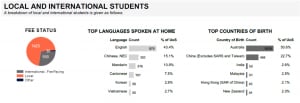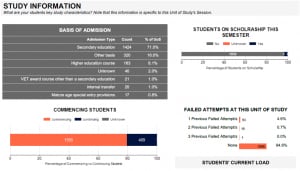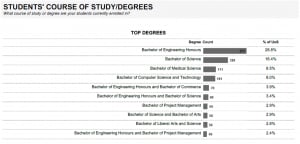As we meet the many smiling faces in the first few classes of semester, we are often left wondering, who are our students exactly? Where have they come from, where are they going, and what else are they doing with their study? The ‘Knowing Your Students’ (KYS) report, available right now for your unit via Blackboard, gives you this background and more.
KYS uses centrally-held information to provide a detailed description of the cohort in each unit of study. It updates each night so that it reflects the sometimes large changes in enrolments that occur over the first few weeks of semester.
How do I get it?

If you are teaching in a unit of study this semester, you can access the report for your students by following the ‘Unit of Study Analytics’ link in the ‘Evaluation’ section of your unit website on Blackboard. The KYS report will appear as one of the options on the next screen. When you click the link to fetch the KYS report, a new tab will pop up and the report will take a short while to load (up to 1-2 minutes depending on the size of your class). A mock report is available here.
What can I do with it?
The KYS report contains a lot of useful information about your cohort. Here are just some examples of the information available, and some practical things you could do with this information.
Local and international students

This area of the KYS report summarises the balance of international and domestic students in your unit, their countries of birth, and majority languages spoken at home. To celebrate and leverage the diversity of students in your unit, you could try and design activities that help students get to know each other, break down barriers, and encourage cultural awareness. Ehssan Sakhaee in the Faculty of Engineering and Information Technology uses this information to build tutorial activities that promote cultural competence in diverse teams of students – check out his story here.
Study information

This area provides summary information of how students entered your unit, how many students are at university for the first time, and how many have previously failed the unit. If you have a high proportion of commencing students, you might want to consider helping to ease their transition to tertiary study through simple but effective strategies such as:
- Reminding students of any orientation activities run by your faculty or school
- Helping your students adjust to university study by better understanding assessment expectations and study approaches
- Making small changes to your Blackboard site to aid navigation and ease confusion
- Helping your students understand the expectations around academic integrity in higher education
For more tips on helping students transition to university, check out this very helpful page. If your unit has a substantial number of students who are repeating, consider running one or two specialised sessions for these students to help them think about how they could better approach studying for your unit.
Course/degree enrolled

It’s often helpful, especially in larger service or generalist units, to know in which degrees and programs your students are enrolled. You can use this area of the KYS report to understand the broad areas that your students are enrolled in, and adjust learning material to be more relevant to them. In one of my biology units, I found out through KYS that there was a substantial majority enrolled in vet and health degrees, yet being a plant molecular biologist I was using examples and applications that didn’t resonate as strongly with large parts of my cohort. Armed with this summary information, I updated lecture content to better suit the career trajectories of my students.
Past and current units of study
This information is powerful because it tells you where the majority of your students have come from (in terms of units completed in the semester just past), and what units they are co-enrolled in this semester. It is really motivating for students to see connections between their units of study, so if you know (or can find out) what other units are teaching, try and link concepts in your unit to those. This could be as simple as, “Last semester, many of you did ABCD1234, where you would have discussed…” in a lecture. It’s important not to assume that all students will have retained (or indeed received!) that linked information, but drawing connections helps your students see the relevance of what they are studying.
Tell me more!
- For more information about the various analytics tools available for teachers, check out this page from the Education Portfolio.





